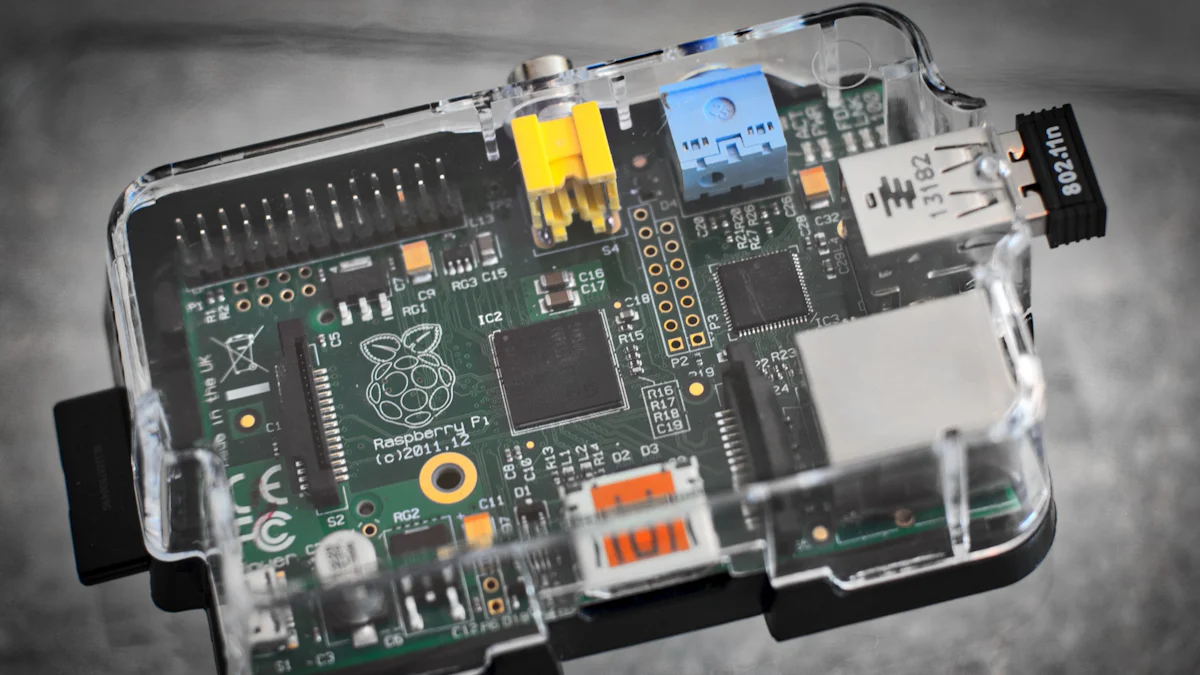Exploring TMS320F28335PGFA in Real-Time Control

Real-time control is essential in modern applications, particularly in industries such as manufacturing and automotive. The demand for automation in these sectors is on the rise, with the U.S. industrial automation market valued at USD 42.87 billion in 2023. This growth underscores the necessity for efficient real-time processing. The TMS320F28335PGFA microcontroller, developed by TI, excels in this area. It provides robust capabilities for real-time control applications, making it a preferred choice for engineers and developers. For more details, visit https://www.alldatasheet.com/view.jsp?Searchword=T.
Understanding the TMS320F28335PGFA Microcontroller
Overview of the TMS320F28335PGFA
The TMS320F28335PGFA microcontroller, developed by TI, stands as a significant advancement in digital signal processing. This microcontroller belongs to the C2000 series, specifically the F2833x family, and it plays a crucial role in real-time control applications. Its development marked a pivotal moment in enhancing the efficiency and precision of industrial automation and motor control systems.
Historical Context and Development
TI introduced the TMS320F28335PGFA to address the growing need for high-performance processors capable of handling complex real-time control tasks. Over the years, it has evolved to support a wide range of applications, from renewable energy systems to power electronics. The microcontroller's ability to process data efficiently has made it indispensable in various industries.
Key Features and Capabilities
The TMS320F28335PGFA boasts several key features that make it ideal for real-time control applications:
High-Resolution PWM: Ensures precise motor control, which is essential in applications demanding accuracy.
ADC, UART, and SPI Communication Interfaces: These functionalities facilitate seamless communication with other devices.
Robust Processing Capabilities: Supports efficient real-time control, enhancing performance in industrial and commercial settings.
Technical Specifications
Understanding the technical specifications of the TMS320F28335PGFA provides insight into its capabilities and why it excels in real-time control applications.
Processor Architecture
The TMS320F28335PGFA utilizes TI’s powerful C28x core, a 32-bit fixed-point digital signal processor (DSP). This architecture allows the microcontroller to execute complex algorithms efficiently, making it suitable for applications like audio and speech processing, sonar, radar, and digital image processing.
Memory and Storage Options
Equipped with 512 KB of flash memory and 68 KB of RAM, the TMS320F28335PGFA can operate smoothly at speeds up to 150 MHz. This memory configuration supports the execution of sophisticated control algorithms, ensuring reliable performance in real-time control applications.
Input/Output Configurations
The microcontroller offers versatile input/output configurations, including PWM generation and various communication interfaces like ADC, UART, and SPI. These features enable the TMS320F28335PGFA to interact effectively with other components in a system, facilitating seamless integration into diverse applications.
For more detailed specifications, you can refer to the datasheet available at https://www.alldatasheet.com/view.jsp?Searchword=T.
Features of TMS320F28335PGFA
Real-Time Processing Capabilities
The TMS320F28335PGFA, developed by TI, excels in real-time control applications due to its impressive processing capabilities. This microcontroller handles complex tasks with remarkable speed and efficiency.
Speed and Efficiency
The TMS320F28335PGFA operates at high speeds, ensuring that real-time control applications run smoothly. Its 32-bit digital signal processor (DSP) architecture allows it to execute complex algorithms quickly. This speed is crucial in industrial automation and motor control, where timely responses are essential. The microcontroller's ability to process data efficiently makes it a preferred choice for engineers working on renewable energy systems and power electronics.
Interrupt Handling
Effective interrupt handling is another strength of the TMS320F28335PGFA. It manages multiple tasks simultaneously without compromising performance. This capability is vital in real-time control applications, where the system must respond to various inputs promptly. The microcontroller's robust interrupt handling ensures that it can maintain high performance even under demanding conditions.
Power Management
Power management is a critical aspect of any microcontroller, and the TMS320F28335PGFA offers advanced features in this area. It provides energy efficiency and power-saving modes, making it suitable for applications where power consumption is a concern.
Energy Efficiency
The TMS320F28335PGFA is designed to be energy-efficient, reducing power consumption without sacrificing performance. This feature is particularly important in applications like renewable energy systems, where conserving energy is a priority. By optimizing power usage, the microcontroller helps extend the lifespan of devices and reduce operational costs.
Power-Saving Modes
In addition to energy efficiency, the TMS320F28335PGFA includes power-saving modes that further enhance its suitability for real-time control applications. These modes allow the microcontroller to reduce power usage during periods of low activity, conserving energy and minimizing heat generation. This capability is beneficial in applications where maintaining a low thermal footprint is essential.
For more detailed specifications and features, you can refer to the datasheet available at https://www.alldatasheet.com/view.jsp?Searchword=T.
Applications in Real-Time Control

The TMS320F28335PGFA, developed by TI, plays a pivotal role in real-time control applications across various industries. Its robust capabilities make it an ideal choice for both industrial automation and automotive systems.
Industrial Automation
In the realm of industrial automation, the TMS320F28335PGFA excels in enhancing efficiency and precision.
Process Control
Process control systems rely heavily on real-time data processing to maintain optimal performance. The TMS320F28335PGFA's high-resolution PWM and efficient data handling capabilities ensure precise control over industrial processes. This microcontroller enables seamless integration with existing systems, allowing for improved monitoring and adjustment of variables such as temperature, pressure, and flow rates. Engineers appreciate its ability to execute complex algorithms swiftly, which is crucial for maintaining stability in dynamic environments.
Robotics
Robotics applications demand quick and accurate responses to changing conditions. The TMS320F28335PGFA, with its advanced interrupt handling and real-time processing power, provides the necessary support for robotic systems. It facilitates smooth operation by managing multiple tasks simultaneously, ensuring that robots can perform intricate maneuvers with precision. This microcontroller's compatibility with various communication interfaces enhances its adaptability in diverse robotic applications, from assembly lines to autonomous vehicles.
Automotive Systems
The automotive industry benefits significantly from the TMS320F28335PGFA's capabilities, particularly in enhancing vehicle performance and safety.
Engine Management
Modern vehicles require sophisticated engine management systems to optimize fuel efficiency and reduce emissions. The TMS320F28335PGFA, with its high-resolution PWM, plays a crucial role in controlling engine parameters. It processes data rapidly, allowing for real-time adjustments that improve engine performance. This microcontroller's energy efficiency also contributes to the overall sustainability of electric vehicles (EVs), making it a valuable asset in the push towards greener automotive solutions.
Safety Systems
Safety systems in vehicles depend on reliable real-time control to function effectively. The TMS320F28335PGFA supports these systems by providing robust processing capabilities that ensure timely responses to potential hazards. Its ability to handle complex algorithms enhances the functionality of features such as anti-lock braking systems (ABS) and electronic stability control (ESC). By improving the reliability and responsiveness of safety systems, this microcontroller contributes to the overall safety of modern vehicles.
For more detailed specifications and features of the TMS320F28335PGFA, you can refer to the datasheet available at https://www.alldatasheet.com/view.jsp?Searchword=T.
Advantages and Limitations
Benefits of Using TMS320F28335PGFA
The TMS320F28335PGFA, developed by TI, offers several advantages that make it a popular choice in real-time control applications.
Performance Advantages
The TMS320F28335PGFA stands out for its exceptional performance. It features a powerful C28x core architecture, which allows it to handle complex algorithms efficiently. This capability is crucial in real-time control applications where speed and precision are paramount. Compared to other microcontrollers like the TMS320F28035, the TMS320F28335PGFA provides stronger performance and more resources, making it suitable for demanding tasks in industrial automation and automotive systems.
Cost-Effectiveness
In addition to its performance, the TMS320F28335PGFA offers cost-effectiveness. Its ability to integrate multiple functions into a single chip reduces the need for additional components, lowering overall system costs. This microcontroller's compatibility with various communication interfaces also simplifies system design, further contributing to cost savings. Engineers and developers appreciate its balance of performance and affordability, making it an attractive option for projects with budget constraints.
Potential Drawbacks
While the TMS320F28335PGFA excels in many areas, it also presents some challenges that users should consider.
Complexity in Programming
One potential drawback of the TMS320F28335PGFA is its complexity in programming. The advanced features and capabilities that make it powerful can also make it challenging to program, especially for those new to real-time control applications. Developers may require additional training or experience to fully leverage its capabilities. However, the investment in learning can pay off in terms of enhanced system performance and functionality.
Compatibility Issues
Compatibility issues may arise when integrating the TMS320F28335PGFA into existing systems. Although it shares similarities with other microcontrollers in the C2000 series, such as the TMS320F28334PGFA, differences in processing power or specific features can lead to integration challenges. Users must ensure that their systems are compatible with the TMS320F28335PGFA's specifications to avoid potential issues.
For more detailed specifications and features of the TMS320F28335PGFA, you can refer to the datasheet available at https://www.alldatasheet.com/view.jsp?Searchword=T.
Frequently Asked Questions (FAQs)
Common Queries
Installation and Setup
What are the initial steps for setting up the TMS320F28335PGFA?
Users should begin by acquiring the necessary development tools. These include a compatible IDE, such as Code Composer Studio, and the appropriate hardware, like a development board. After gathering these tools, they should install the IDE on their computer. Following installation, users must connect the development board to the computer using a USB cable. This connection allows for programming and debugging.
How can one configure the microcontroller for a specific application?
Configuration involves setting up the microcontroller's peripherals and registers. Users should refer to the datasheet for detailed information on register settings. They can access the datasheet at https://www.alldatasheet.com/view.jsp?Searchword=T. The datasheet provides guidance on configuring PWM, ADC, and communication interfaces. Proper configuration ensures optimal performance for the intended application.
Are there any recommended practices for programming the TMS320F28335PGFA?
Users should follow structured programming practices. This includes writing modular code and using comments for clarity. Additionally, they should test each module individually before integrating it into the main program. This approach helps in identifying and resolving issues early in the development process.
Troubleshooting Common Issues
What should users do if the microcontroller does not respond after programming?
Users should first check the power supply to ensure the microcontroller receives adequate power. Next, they should verify the connections between the development board and the computer. Loose or incorrect connections can cause communication failures. If the issue persists, users should review the code for errors and reprogram the microcontroller.
How can one address communication problems with peripheral devices?
Communication issues often arise from incorrect configuration of communication interfaces. Users should double-check the settings for UART, SPI, or I2C interfaces. They should also ensure that the peripheral devices are powered and properly connected. Reviewing the datasheet can provide additional insights into resolving these issues.
What steps can users take if they encounter unexpected behavior during operation?
Users should begin by isolating the problem. They can do this by testing individual components of the system. If the issue relates to software, reviewing the code for logical errors is essential. For hardware-related problems, users should inspect the connections and components for faults. Consulting the datasheet can offer further troubleshooting tips.
The TMS320F28335PGFA plays a crucial role in real-time control applications. Its high-performance 32-bit digital signal processor excels in industrial automation, motor control, and renewable energy systems. This microcontroller's robust capabilities ensure efficient processing and signal handling. As industries continue to evolve, the TMS320F28335PGFA holds significant potential for future advancements. Its adaptability and efficiency make it a valuable asset for engineers and developers. For more detailed specifications, visit https://www.alldatasheet.com/view.jsp?Searchword=T.
See Also
Discovering the XC95144XL-10TQG144C Xilinx PLD Specs
Comprehending STM8S003F3P6TR MCU Uses in Embedded Systems
Utilizing the HD6477043F28 MCU in Your Projects

